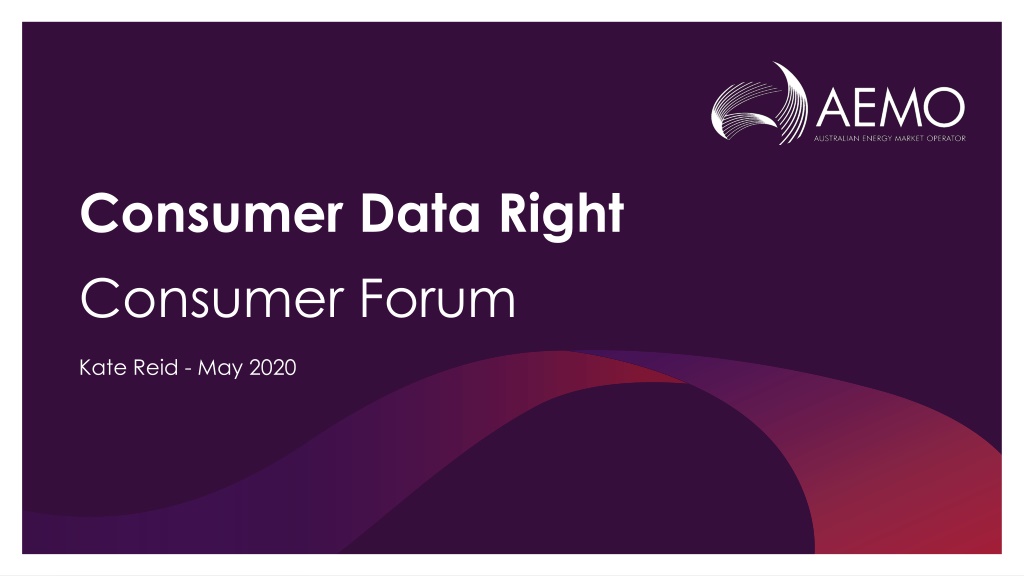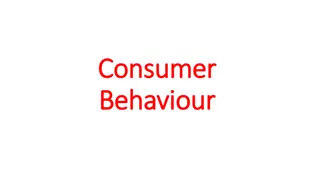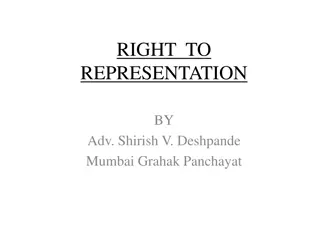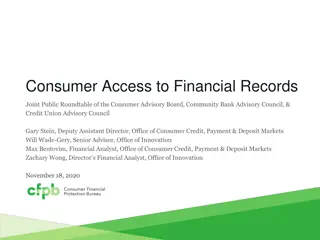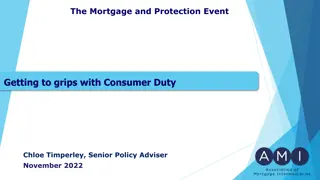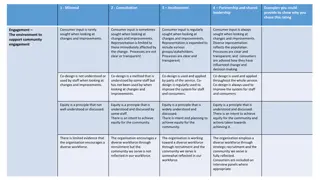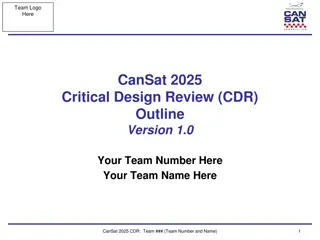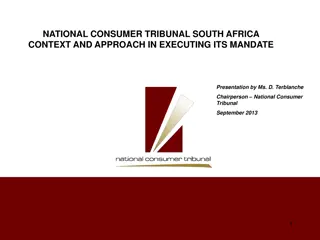Understanding Consumer Data Right in Energy: A Guide to CDR Framework and Implementation
The Consumer Data Right (CDR) in the energy sector aims to empower consumers with better decision-making capabilities by enabling access to valuable data. This comprehensive guide covers key aspects such as engagement on CDR, AEMO's role, how CDR works, and the proposed framework approach. Learn about data standards, accreditation, and the facilitation of interactions between consumers, Data Holders, and Accredited Data Recipients. Discover the principles-based approach and the ongoing consultations shaping the future of CDR in the energy industry.
Download Presentation

Please find below an Image/Link to download the presentation.
The content on the website is provided AS IS for your information and personal use only. It may not be sold, licensed, or shared on other websites without obtaining consent from the author. Download presentation by click this link. If you encounter any issues during the download, it is possible that the publisher has removed the file from their server.
E N D
Presentation Transcript
Consumer Data Right Consumer Forum Kate Reid - May 2020
Agenda 1. 2. 3. 4. 5. 6. 7. 8. 9. 10. Contact Us Engagement on CDR CDR How it works Role of AEMO AEMO s proposed approach to framework Authentication under a two-tier approach Future CDR enabled services Estimated uptake Benefits of the Approach CDR Implementation
Engagement on CDR in Energy Development of Energy CDR framework will be driven by three implementation bodies. Retailers (Data Holders) and Accredited Data Recipients (ADRs) Designation Instrument Data Holders, datasets. CDR Framework & Rules: Definition of Consumer, Gateway role and dataflows, authentication, authorisation, Consumer dashboards & accreditation rules. CDR in Energy phasing mechanisms. CX Standards: CX research topics to support rule decisions. Data Standards Technical requirements and classifications for designated data. Info security standards. Indicative Period: May June 2020 Data Designation Consultation Consumer Groups Market Bodies Australian Energy Market Operator Now Open for submissions on the Draft Designation Instrument. Indicative Period: April Oct 2020 April Jan 2021 Data standards workshop: 29 April DSB CX & Data Indicative Period: May June 2020 August Nov 2020 Submissions close 31 May 2020. CX Standards Overview CX Standards Consultations Technical Data Standards Overview Technical Data Consultations CDR in Energy Framework & Rules Consultations Treasury ACCC AEMO has a key role in delivering the CDR through building a gateway to facilitate the interactions between eligible CDR consumers, Data Holders and ADRs. As a key participant AEMO can support stakeholders by providing an energy sector view to these regulatory processes.
CDR How It Works The overarching objective of the CDR in energy is to enable consumers to make better and more informed decisions about their energy consumption. Enables value Data Holder Consumer AEMO Gateway Accredited Data Recipient Enables value Enables data access/ authentication Enables data access/ authentication Consumer Data Holder Accredited Data Recipient Enables value Data Holder Consumer Accredited Data Recipient ACCC Accreditation
AEMO role Providing an interface for ADRs to request CDR data Facilitation of CDR transactions between consumers, Data Holders and ADRs Confirming accreditation, authentication, consent and authorisation before disclosing data via the gateway Data Holder for NMI Standing, Metering and DERR data Sourcing and supplying CDR data
AEMOs proposed approach to framework AEMO proposes a principles-based approach for energy. There is an opportunity to cascade the sound principles in the CDR legislation into the rules framework for energy while taking into account energy data policy considerations. Principles-based approach in the law Consider data policy considerations Rules that apply principles for best outcomes in the energy sector Defining relevant data sets to leverage existing data holdings, driving practical uses for consumers Defining eligible consumer in a way that is relevant to the energy sector Rules that protect privacy while encouraging uptake and innovation Avoid unnecessary prescription to allow innovation and maturity of CDR in the sector The interests of consumers The efficiency of relevant markets The privacy or confidentiality of consumers information Promoting competition Promoting data driven innovation Any intellectual property in the information to be covered by the instrument The public interest The likely regulatory impact Relationship between the data holder and consumer Differences in energy data and banking data model Low levels of digital consumer accounts in energy Multiple individuals at a single NMI without a retail relationship Only one electricity product offer can apply per household (noting potential for multiple trading relationship and bundling)
Authentication under a two-tier approach AEMO supports a two-tiered approach to authentication and accreditation. This approach reflects the differentiation of access possible, based on; Consumer type, Sensitivity of the data application, and Accredited service provided by the ADR to the consumer based on CDR Data requested. Tailored Product Generic Product Consumer Provided Authentic -ation Data Set Metering Standing DERR Billing Accreditation Consumer Definitions Resident Request Data sensitivity - Lower X X X Basic Specific Account Holder Request Data sensitivity - Higher Product Data (no authentication) X X X X X X Full Standard X N/A Standard
Future CDR enabled services 01 02 03 The most commonly desired data sets can be used to enable a number of customer valued products and services. Energy efficiency and monitoring Customer acquisition Quoting Tools Products and services that enable detailed monitoring and comparison of energy consumption and generation, including: Rooftop solar virtual management Forecasting DER efficiency Consumption benchmarking and comparison High consumption alerts Thermal analysis Businesses are hoping to use both household-specific and postcode- level data to identify gaps in the market in which they could fill, inducing: Gaps in solar adoption Gaps in energy efficiency Bundling and rebate opportunities Data-driven quoting tools will enable businesses to provide more accurate and cost-effective products and services, looking at a broad range of areas including: Forecasting Consumption vs generation Alternatives Tariff breakdowns If you just focus on metering data, that s 80% of the value Most commonly desired data sets: Metering data Generic tariff data NMI Standing data Most commonly desired data sets: Metering data NMI Standing data Generic tariff data Most commonly desired data sets: Metering data Generic tariff data - Anonymous adoovate.
Estimated uptake Uptake under an account model only: 2 of 10 energy consumers Uptake could be limited if only consumers be eligible to use the CDR if all banking criteria applied (an account holder that is18 years old or older (for individuals), has an open account, and the account can be accessed online). Uptake if a resident model is available: 9 of 10 energy consumers Uptake would be maximised under a resident model which only requires access to a bill and enables a simple and easy consumer experience. These are only estimates only.
Benefits of AEMOs Approach AEMO s proposed gateway model and two tiered approach to delivers benefits to both participants and consumers. By leveraging the construct of an intermediated model in the context of the CDR, the proposed approach is a solution that acknowledges existing industry structures and relationships and recognises the importance of data to the sector, both today and into the future. 01 02 03 04 05 Unlock Valuable Datasets Reduce Rigorous Overheads Maximize customer access Cost Effectiveness Scalability To existing and emerging innovative energy services that can save consumers money Two-tiered approach enables secure, easy, and simple access for highest value use cases For participants & consumers by managing consent & authorization Prioritising cost effective implementation will minimise costs to consumers Implementing a model that can expand to cover future needs
CDR Implementation - indicative 2019 2020 2021 2022 Q1 Q2 Q3 Q4 Q1 Q2 Q3 Q4 Q1 Q2 Q3 Q4 Q1 Q2 5MS implementation Draft Designation Inst Made Instructions Rules Draft Rules Finalised Draft Standards Finalise Standards Go Live Go Live Conceptual Design Design Industry Testing Build & Test
Contact Us Luke Wines Kate Reid AEMO Project Lead Emerging Markets & Services Email: luke.wines@aemo.com.au Tel: 0401 200 725 Stakeholder Relations Email: kate.reid@aemo.com.au Tel: 0420 242 384 Australian Energy Market Operator Australian Energy Market Operator
